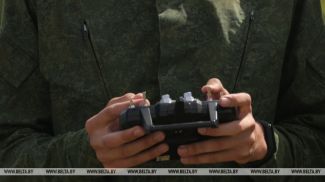
OSTROVETS, 1 October (BelTA) - The operational work at the BelNPP fully complies with international norms and standards, IAEA Director General Rafael Grossi told the media as shared his impressions of the visit to the plant, BelTA learned.
"I visited this very important nuclear power plant for the first time. My visit began with a very warm meeting with Belarusian President Aleksandr Lukashenko. We exchanged views on the situation in nuclear energy in the world as a whole, on safety issues in this area, and on the situation in the neighboring countries. The president assured me that Belarus intends to continue close cooperation with the IAEA, especially on ensuring the safety of the Belarusian NPP and other plants that may be built in the future. During the visit to the plant, I was able to see the working process and make sure that the operational work at the plant fully complies with international norms and standards," Rafael Grossi said.
He noted that the IAEA was involved in the construction of the BelNPP from the very beginning, providing expert assistance. "The process of building nuclear power plants is very complex. Few countries in the world can afford it," the IAEA head noted.
"We assured each other that the IAEA and Belarus will continue to cooperate. We agreed on this with the president and the deputy prime minister [Viktor Karankevich]. It's about clean energy, so we'll continue our interaction. It is very important that the situation at the plant complies with all international standards," Rafael Grossi concluded.
Cooperation with the IAEA is multilateral and covers a wide range of areas. The agency assists Belarus in addressing the most important issues on the national nuclear power program, nuclear energy infrastructure and nuclear safety. The IAEA provided Belarus with technical and expert support at all stages of the BelNPP construction. IAEA assessment missions have become an important element of the joint work. From 2012 to 2022, all key missions of the agency, recommended for countries building their first NPP, were carried out in Belarus. They confirmed the BelNPP compliance with the highest safety requirements. Moreover, Belarus’ successful experience and practices in a number of areas serve as an example for other countries that start developing nuclear power industry.
The Belarusian nuclear power plant uses the Russian design AES-2006 featuring two VVER-1200 reactors with the total output capacity of 2,400MW. It is an evolutionary nuclear power plant design with third-generation water-moderated reactors. Such designs boast improved technical and economic parameters. A unique combination of active and passive safeguards makes the nuclear power plant extremely resilient to external and internal impacts. The double shell of the reactor building will protect the Belarusian nuclear power plant in the event of an earthquake, hurricane, flood, explosion and other external impacts.
"I visited this very important nuclear power plant for the first time. My visit began with a very warm meeting with Belarusian President Aleksandr Lukashenko. We exchanged views on the situation in nuclear energy in the world as a whole, on safety issues in this area, and on the situation in the neighboring countries. The president assured me that Belarus intends to continue close cooperation with the IAEA, especially on ensuring the safety of the Belarusian NPP and other plants that may be built in the future. During the visit to the plant, I was able to see the working process and make sure that the operational work at the plant fully complies with international norms and standards," Rafael Grossi said.
He noted that the IAEA was involved in the construction of the BelNPP from the very beginning, providing expert assistance. "The process of building nuclear power plants is very complex. Few countries in the world can afford it," the IAEA head noted.
"We assured each other that the IAEA and Belarus will continue to cooperate. We agreed on this with the president and the deputy prime minister [Viktor Karankevich]. It's about clean energy, so we'll continue our interaction. It is very important that the situation at the plant complies with all international standards," Rafael Grossi concluded.
Cooperation with the IAEA is multilateral and covers a wide range of areas. The agency assists Belarus in addressing the most important issues on the national nuclear power program, nuclear energy infrastructure and nuclear safety. The IAEA provided Belarus with technical and expert support at all stages of the BelNPP construction. IAEA assessment missions have become an important element of the joint work. From 2012 to 2022, all key missions of the agency, recommended for countries building their first NPP, were carried out in Belarus. They confirmed the BelNPP compliance with the highest safety requirements. Moreover, Belarus’ successful experience and practices in a number of areas serve as an example for other countries that start developing nuclear power industry.
The Belarusian nuclear power plant uses the Russian design AES-2006 featuring two VVER-1200 reactors with the total output capacity of 2,400MW. It is an evolutionary nuclear power plant design with third-generation water-moderated reactors. Such designs boast improved technical and economic parameters. A unique combination of active and passive safeguards makes the nuclear power plant extremely resilient to external and internal impacts. The double shell of the reactor building will protect the Belarusian nuclear power plant in the event of an earthquake, hurricane, flood, explosion and other external impacts.













